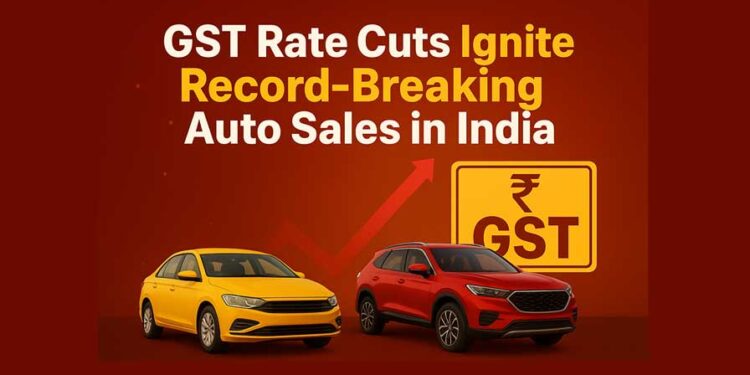Introduction
GST Rate Cuts have revolutionized India’s automobile market, triggering a record-breaking sales surge during the 2025 festive season. Effective from September 22, 2025, the GST 2.0 reforms slashed tax rates and eliminated the compensation cess, making vehicles more affordable. Small cars, two-wheelers, and SUVs now fall under a unified 18% GST slab, down from 28% plus cess (up to 43% effective), delivering savings of ₹70,000 to ₹2 lakh per vehicle. This blog explores how GST rate cuts sparked an unprecedented auto sales boom, revitalized the industry, and fueled a blockbuster festive season.
The GST 2.0 Reforms: A Catalyst for Change
The GST rate cuts, part of the GST 2.0 initiative announced on September 3, 2025, during the 56th GST Council meeting, simplified India’s tax structure. For automobiles, the changes were transformative:
- Elimination of Compensation Cess: The 1-15% cess on top of 28% GST was removed, instantly reducing on-road prices.
- Unified 18% GST Rate: Small cars (petrol <1,500cc, diesel <1,200cc), two-wheelers, and SUVs shifted to 18%, cutting prices by 8-12%.
- Festive Timing: The GST rate cuts aligned with Navratri (September 23, 2025), a peak auto-buying period, amplifying demand.
Anticipation of the GST rate cuts caused a 75-80% sales drop in early September as buyers delayed purchases, setting the stage for a dramatic rebound.
The Sales Surge: A Festive Blockbuster
The GST rate cuts unleashed a buying frenzy, with dealerships reporting record sales from September 22. Key highlights include:
- Booking Surge: Bookings doubled, with inquiries for compact cars and two-wheelers hitting 80,000 pre-festive for top brands.
- Record Deliveries: On Day 1, deliveries soared to 5x the average, with one manufacturer logging 30,000 units. Over 80,000 vehicles have been sold since Navratri began.
- Two-Wheeler Revival: Motorcycles and scooters, now 8-10% cheaper due to GST rate cuts, saw a sharp uptick, especially in rural markets recovering from FY24’s slowdown.
- Festive Projections: Industry estimates project an 8% year-on-year growth, adding ~1 lakh units. Passenger vehicle sales could reach 4.2 million units in FY26, with 15-20% of the growth tied to GST rate cuts.
Showrooms in Tier-1, Tier-2, and Tier-3 cities reported unprecedented footfall, with rural demand rebounding as two-wheeler affordability improved.
Consumer Savings: Driving Affordability
The GST rate cuts delivered significant savings, making vehicles accessible to India’s middle class:
- Compact Cars: A ₹5 lakh hatchback, like the Maruti Swift or Hyundai Venue, saves buyers ~₹70,000, easing EMI burdens.
- Premium SUVs: Models priced at ₹15 lakh, such as the Hyundai Creta, saw savings of ₹1-2 lakh, spurring aspirational purchases.
- Two-Wheelers: Motorcycles and scooters, critical for rural and semi-urban buyers, became 8-10% cheaper, boosting sales for brands like Bajaj, Hero MotoCorp, and TVS.
These savings cleared dealer inventories, which had hit a critical 70-75 days in August due to the pre-cut slowdown.
Economic Impact: Beyond the Showroom
The auto sector’s boom, driven by GST rate cuts, has far-reaching economic effects:
- Inventory Normalization: High stocks began clearing as sales surged, reducing inventory days to sustainable levels.
- Stock Market Rally: Auto stocks soared 4-10%, hitting 10-month highs, reflecting investor optimism.
- Job Creation: The sales frenzy prompted a 20-25% increase in temporary hiring for dealerships and logistics.
- Rural Recovery: Affordable two-wheelers revitalized rural markets, setting a positive tone for FY26.
Analysts predict the auto sector’s momentum could contribute 8-12% to consumer durables growth in 2026, aligning with India’s ₹5 trillion economy ambitions.
Challenges and Future Outlook
Despite the success of GST rate cuts, challenges remain. The pre-announcement sales dip strained dealers, and some note tax structure complexities due to exemptions. However, the festive season momentum overshadows these concerns. With Diwali approaching, the auto sector is poised for its strongest performance in years.
Conclusion: A Roadmap for Growth
The GST rate cuts have redefined India’s automobile market, transforming uncertainty into a historic sales surge. By slashing taxes and boosting affordability, the government has empowered consumers, cleared inventories, and revitalized a key industry. As showrooms buzz and rural buyers return, the festive season is a turning point. For anyone eyeing a new car or bike, now is the time to seize the savings and join the GST rate cuts-fueled auto boom.










